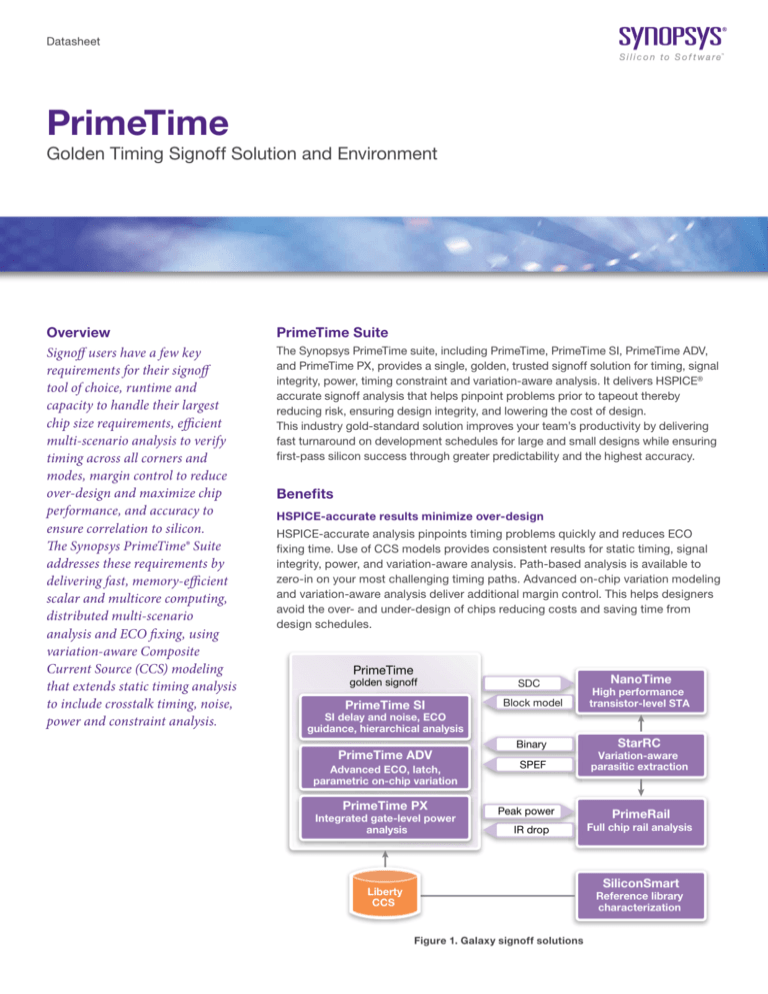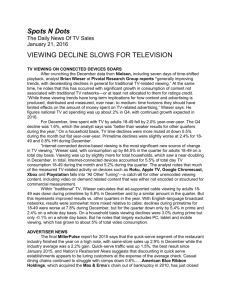
Datasheet
PrimeTime
Golden Timing Signoff Solution and Environment
Overview
Signoff users have a few key
requirements for their signoff
tool of choice, runtime and
capacity to handle their largest
chip size requirements, efficient
multi-scenario analysis to verify
timing across all corners and
modes, margin control to reduce
over-design and maximize chip
performance, and accuracy to
ensure correlation to silicon.
The Synopsys PrimeTime® Suite
addresses these requirements by
delivering fast, memory-efficient
scalar and multicore computing,
distributed multi-scenario
analysis and ECO fixing, using
variation-aware Composite
Current Source (CCS) modeling
that extends static timing analysis
to include crosstalk timing, noise,
power and constraint analysis.
PrimeTime Suite
The Synopsys PrimeTime suite, including PrimeTime, PrimeTime SI, PrimeTime ADV,
and PrimeTime PX, provides a single, golden, trusted signoff solution for timing, signal
integrity, power, timing constraint and variation-aware analysis. It delivers HSPICE®
accurate signoff analysis that helps pinpoint problems prior to tapeout thereby
reducing risk, ensuring design integrity, and lowering the cost of design.
This industry gold-standard solution improves your team’s productivity by delivering
fast turnaround on development schedules for large and small designs while ensuring
first-pass silicon success through greater predictability and the highest accuracy.
Benefits
HSPICE-accurate results minimize over-design
HSPICE-accurate analysis pinpoints timing problems quickly and reduces ECO
fixing time. Use of CCS models provides consistent results for static timing, signal
integrity, power, and variation-aware analysis. Path-based analysis is available to
zero-in on your most challenging timing paths. Advanced on-chip variation modeling
and variation-aware analysis deliver additional margin control. This helps designers
avoid the over- and under-design of chips reducing costs and saving time from
design schedules.
PrimeTime
golden signoff
PrimeTime SI
SDC
Block model
NanoTime
High performance
transistor-level STA
SI delay and noise, ECO
guidance, hierarchical analysis
PrimeTime ADV
Advanced ECO, latch,
parametric on-chip variation
PrimeTime PX
Integrated gate-level power
analysis
Binary
SPEF
Peak power
IR drop
StarRC
Variation-aware
parasitic extraction
PrimeRail
Full chip rail analysis
SiliconSmart
Liberty
CCS
Reference library
characterization
Figure 1. Galaxy signoff solutions
Integrated design environment improves productivity
The unified analysis environment in the PrimeTime Suite enables designers to perform complete timing, signal
integrity, timing constraint, power and variation-aware analysis in a single environment. This improves designer
productivity, reduces set-up steps, and minimizes the number of interface files created and used. It also
leads to faster time-to-¬results because identical operations, such as timing and slew calculations, are not
repeated. Costs are minimized by eliminating the need for multiple point tools with associated support costs.
Fast turn-around time
PrimeTime offers a range of solutions to reduce the time required for analysis and signoff. Highly scalable
multicore support reduces the time required for static timing and signal integrity analysis by taking advantage
of the runtime benefits of threaded parallel processing. Distributed Multi-Scenario Analysis (DMSA)
allows multiple scenarios to be run concurrently, which reduces wall clock time and produces a single
comprehensive timing report.
High capacity
PrimeTime performance and capacity improve release over release to take full advantage of the latest
multicore compute hardware available in design farms. PrimeTime uses disk-caching for scalable multithreading delivering fast performance in a low memory footprint.
Comprehensive signoff
Comprehensive timing and design rule checking, extensive design constraint annotation and delay reporting allow
ASIC and COT designers to signoff with confidence knowing that all aspects of their designs have been analyzed.
Advanced node support
PrimeTime supports the latest process node requirements at 16-nm and below, including advanced waveform
propagation technology that accurately models waveform distortion at advanced nodes, especially in ultra-low
voltage FinFET technology.
PrimeTime
The Synopsys PrimeTime static timing analysis solution is the most trusted and advanced timing signoff
solution for gate-level designs. It is the standard for gate-level static timing analysis with the capacity and
performance for 500+ million instance chips being designed at 28-nm and below. PrimeTime static timing
analysis and StarRC™ parasitic extraction are key components of the Galaxy™ Design Platform.
The PrimeTime STA solution provides designers with extensive timing analysis checks, on-chip variation
analysis techniques, golden delay calculation, advanced modeling, unmatched productivity and ease-of-use,
a graphical user interface and industry-wide ASIC vendor signoff and foundry support.
The PrimeTime static timing analysis solution provides the foundation and environment for a suite of
extensions in signoff analysis. In addition to timing analysis, PrimeTime SI, PrimeTime ADV and PrimeTime PX
deliver extensions for signal integrity analysis, advanced ECO guidance and variation-aware analysis and
leakage and dynamic power analysis.
Golden delay calculator
PrimeTime’s built-in RC delay calculator uses parasitic information and Composite Current Source (CCS)
libraries to calculate cell and interconnect delays with SPICE-like accuracy. The delay calculation and
parasitic annotation reporting capabilities enable designers to debug and pinpoint timing problems. The
PrimeTime delay calculator supports voltage and temperature scaling between libraries. This enables multivoltage analysis without the need to maintain a large collection of libraries for each unique Process Voltage
Temperature (PVT) point.
Advanced on-chip Variation (AOCV) analysis
At 65-nm and above, the traditional approach of using a global derate margin to account for on-chip
variations (OCV) can provide margin control to account for process variation. At process nodes below 65-nm
PrimeTime’s advanced on-chip variation (Advanced OCV) modeling capability extends OCV analysis to deliver
an improved method of adding margin in a design. Advanced OCV uses context-specific derate factors that
consider location and logic depth of each path being analyzed providing a more accurate method of assigning
on-chip variation margins.
2
Distributed Multi-Scenario Analysis (DMSA)
Signoff verification requires analysis of many individual scenarios that represent different operational modes
and voltage, temperature and process corners. Analyzing and managing the analysis of these scenarios is
simplified with PrimeTime’s Distributed Multi-Scenario Analysis (DMSA) capability. DMSA allows designers to run
distributed timing analysis, and ECO fixing simultaneously across multiple scenarios, thereby reducing overall
turnaround time. Accompanying visualization capabilities accelerate the debug of multi-scenario analysis results.
Additional Features in PrimeTime
``
Advanced modeling capabilities with Interface Logic Models (ILM) and Extracted Timing Models (ETM)
``
UPF (Unified Power Format) support
``
Graphical User Interface (GUI) enabling timing analysis and design visualization using schematics,
histograms, tables, and tree graphs
``
Session save and restore
``
ASIC vendor signoff and foundry support
``
Extensive support for industry-standard input and output file formats
PrimeTime SI
With shrinking process geometries and rising clock frequencies for nanometer designs, signal integrity (SI)
effects such as crosstalk delay and noise (or glitch) propagation can cause functional failures or failed timing.
The PrimeTime SI solution extends the PrimeTime static timing analysis and signoff environment by adding
accurate crosstalk delay, noise (glitch), and voltage (IR) drop delay analysis to address signal integrity effects
at 90-nm and below.
Easy deployment and use
PrimeTime SI is easy to use and adopt. It utilizes the familiar PrimeTime flow and environment, with common
commands, user interface, reports and attributes.
Comprehensive SI analysis
The unified approach of signal integrity and timing analysis delivers a comprehensive and time-efficient
method to analyze noise and crosstalk delay effects on timing. Analysis in a single tool enables faster results
while improving designer productivity.
Accurate crosstalk delay, noise (glitch) and IR drop analysis
Signal integrity effects are interdependent and need to be analyzed in the context of timing. PrimeTime SI uses
an integrated delay calculation engine with the PrimeTime static timing analysis engine to accurately model
and compute timing deviations due to crosstalk and IR drop. (See figure 2). PrimeTime SI has the capacity and
performance to perform accurate noise calculation, detection, and propagation on the largest of today’s designs.
Aggressor
Cs
Cw
Victim
Timing impact
Slow-down
effect
Speed-up
effect
Time
Figure 2. Crosstalk delay analysis pinpoints crosstalk timing failures
3
Multi-scenario ECO guidance
PrimeTime’s signoff-accurate ECO guidance enables a fast ECO closure flow. Optimum fixes for both timing
and DRC violations are identified using the composite view available in the PrimeTime multi-scenario timing
environment, avoiding iterative bottleneck analysis associated with multi-scenario ECOs. PrimeTime’s
integrated ECO solution offers timing-aware DRC fixing for maximum capacitance, transition and fanout, and
timing fixes that honor DRC.
ECO guidance is resource efficient, working either on a single box or a distributed compute farm. In the event
that limited hardware resources are available, ECO can be completed where the number of scenarios is less
than the number of available hosts.
Simultaneous multi-voltage aware analysis
Multi-voltage designs require exhaustive analysis of cross voltage domain paths to ensure all worst case paths
are identified under all voltage combinations. Simultaneous multi-voltage aware analysis (SMVA) completes
analysis of all cross-domain paths under all voltage scenarios in a single run, without the need for margining
that can add pessimism.
Constraint analysis
PrimeTime improves designer productivity through look-ahead timing constraint analysis and debug
technology tuned for the Synopsys Design Platform. Early feedback on constraint quality leads to more
efficient runtimes and better quality of results in synthesis, physical implementation and static timing
analysis tools.
PrimeTime provides an intuitive interactive environment for designers to assess the correctness and
consistency of timing constraints. This helps to eliminate trial-and-error iterations during implementation and
results in more predictable schedules.
Figure 3. PrimeTime constraint analysis interactive environment
Mode merging
With increased design complexity available at smaller process nodes comes the need for additional operating
and test modes. This can increase the number of scenarios required for timing closure and signoff. PrimeTime
mode merging technology identifies superset modes that together replicate how a given design is constrained
by the original individual mode constraints.
4
Mode merging uses the PrimeTime distributed multi-scenario analysis (DMSA) infrastructure, and can be
added to an existing PrimeTime setup for a multi-scenario design.
Additional Features in PrimeTime SI
``
Reduces false violations by considering slew propagation, timing windows, and logical correlation of signals
``
Advanced waveform propagation accounts for waveform distortions at 20-nm and below that can
impact timing
``
Multi-voltage support
``
SPICE deck output
``
Includes HyperScale next generation Hierarchical Timing Analysis technology
``
Hierarchical SI analysis capabilities using ILMs with crosstalk
PrimeTime ADV
PrimeTime ADV offers advanced technology to extend the scope of signoff-driven ECO closure, and provide a
next-generation on-chip variation solution.
Physically-aware multi-scenario ECO guidance
Physically-aware ECO Guidance works closely with IC Compiler’s Minimum Physical Impact (MPI)
technology, allowing routing and placement-aware timing, noise and DRC violation fixes that accelerate
timing convergence by minimizing disruption to an existing layout — something that’s especially important for
congested designs.
In a hierarchical implementation and signoff flow, PrimeTime provides ECO guidance that complies
with physical hierarchy specifications, including multiply-instantiated modules (MIMs) and multivoltage configurations.
ECO power recovery
PrimeTime ECO Guidance can take advantage of positive timing slack to identify power reduction changes to
the netlist without creating new timing violations.
PrimeTime ECO power recovery reduces total power and frees up available space for later ECO opportunities.
After timing is closed, a final leakage recovery step gains additional power reduction with zero impact to
physical design.
PrimeTime
power recovery
PrimeTime
DRC and noise ECO guidance
PrimeTime
timing ECO guidance
PrimeTime
final leakage recovery
Best results
Figure 4. PrimeTime ECO power recovery flow
5
POCV
POCV is the next generation of variation analysis targeted at 14/16nm and below processes. It provides
a lightweight statistical margining approach to variation margining. It offers Graph-based Analysis (GBA)
pessimism reduction, improved PrimeTime ECO turnaround time, and simpler library characterization than the
Advanced OCV approach.
Advanced latch analysis
PrimeTime ADV provides analysis of the latch-based designs used in power-sensitive applications. Both
PrimeTime timing analysis and ECO guidance take the timing characteristics of latches into account.
Support for advanced latch analysis allows ECO fixes to be appropriately distributed up- and downstream
from latches.
Additional Features in PrimeTime ADV
``
ECO sequential cell sizing
PrimeTime PX
The PrimeTime PX solution expands the PrimeTime timing and signal integrity environment to deliver dynamic
and leakage power analysis. Designers have a single, unified analysis environment for timing, signal integrity
and power analysis that is anchored by the PrimeTime static timing solution.
By combining timing, signal integrity and power analysis into a single tool environment, common operations
(e.g. netlist and parasitic reading) are not repeated. The PrimeTime PX solution delivers up to two times
(2x) faster time-to-results (TTR) over separate, standalone solutions. As an integral part of the PrimeTime
environment, power analysis can be performed using PrimeTime commands, reports, attributes and
debugging features.
Full-chip timing, SI and power analysis
The unified analysis environment allows designers to perform leakage and dynamic power analysis along with
timing and SI analysis.
Designers can understand the trade-offs and effects of leakage and dynamic power in the context of complete
timing, signal integrity and power analysis by adopting the easy-to-use PrimeTime PX methodology.
Vector-free dynamic power analysis
Vector-free dynamic power analysis allows power analysis to be performed without waiting for switching data
from simulation. By using the PrimeTime tool’s accurate timing windows, vector-free analysis enables power
analysis early in the design flow to identify blocks with the highest power consumption sooner.
Additional Features in PrimeTime PX
``
Event-based dynamic power analysis using VCD or SAIF
``
RTL and gate-level VCD and SAIF support
``
Instantaneous and cycle-accurate peak power analysis
``
Average power analysis
``
State-dependent leakage power analysis
``
Analysis of advanced low power design techniques: multi-voltage, coarse-grain MTCMOS
``
Clock tree power estimation
``
Power analysis driver GUI window
``
Distributed Peak Power Analysis
``
UPF support
``
Supports industry-standard NLDM and CCS Power libraries
6
Galaxy Signoff Modeling and Platform Support
Advanced modeling
The PrimeTime Suite provides a wide range of advanced modeling support. Interface Logic Models (ILM) are
provided for hierarchical static timing analysis. Extracted Timing Models (ETM) are provided, in .lib format, for
cell-based reusable IP and physical design flows. A complete set of validation, debugging and model merging
features are also provided. HyperScale hierarchical analysis technology offers hierarchical analysis and
signoff, with the information captured in saved sessions acting as block models.
Platform Support
The following platforms are supported: Linux RHEL64, Sparc64, and SUSE 64.
About Galaxy Design Platform
The Galaxy Design Platform is an open, integrated design platform with tools and IP, enabling advanced
semiconductor design. Anchored by Synopsys’ industry-leading semiconductor design tools and the open
Milkyway™ database, the Galaxy Design Platform incorporates consistent timing, SI analysis, common
libraries, delay calculation, constraints, testability and physical verification to provide a convergent flow from
RTL all the way to silicon. The Galaxy Design Platform helps reduce design time, decrease integration costs
and minimize the risks inherent in advance, complex semiconductor design.
Synopsys, Inc. • 690 East Middlefield Road • Mountain View, CA 94043 • www.synopsys.com
©2016 Synopsys, Inc. All rights reserved. Synopsys is a trademark of Synopsys, Inc. in the United States and other countries. A list of Synopsys trademarks is
available at http://www.synopsys.com/copyright.html . All other names mentioned herein are trademarks or registered trademarks of their respective owners.
03/02/16.CE_CS7037_PrimeTime_DS.







